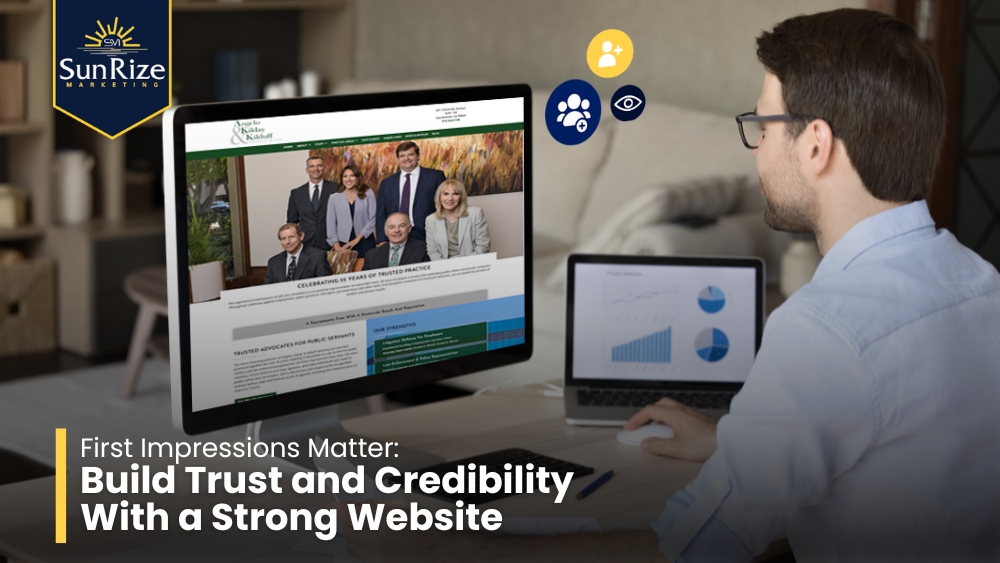This is the first educational article in our blog series, The Legal Marketing Journey: Turning Web Visitors Into Paying Clients – a practical roadmap designed to help law firms improve how they attract, engage, and convert online prospects.
Every day, potential clients are landing on your law firm’s website. They’re searching for legal help, reviewing your practice areas, and deciding—often in seconds—whether to take the next step.
But too often, the journey ends there.
According to the American Bar Association’s 2023 Websites and Marketing Survey, nearly half of legal consumers begin their search for a lawyer online, and most visit a law firm’s website before making contact. And yet, many of those visits never result in a call, consultation, or retained client.
In this article, we explore why that disconnect happens—and how your website’s first impression can make or break a client relationship before it even begins.
The 15-Second Rule
A study by Nielsen Norman Group found that users often leave a website within 10 to 20 seconds if they don’t find a reason to stay. That means your homepage must immediately answer:
- What type of law do you practice?
- Who do you help?
- Why should someone trust you?
Yet many law firm websites open with vague, boilerplate language like “Serving Your Legal Needs Since 1998” – which doesn’t speak to the user’s concerns or urgency.
What to do instead:
- Use a headline that clearly states your specialty and location.“Trusted Criminal Defense in Miami – Available 24/7” is clear, reassuring, and direct.
- Add a subheading that addresses client outcomes, e.g., “We help you protect your rights and your future.”
Outdated Design Damages Credibility
Research by Stanford University’s Web Credibility Project shows that 75% of users judge a company’s credibility based on its website design. For law firms, that credibility is everything.
Outdated visuals, cluttered layouts, and poor mobile design can instantly erode trust—even before a word is read.
How to fix this:
- Prioritize mobile-first design: Over 60% of legal-related searches now happen on mobile (Google Legal Trends Report, 2023).
- Invest in clean, modern aesthetics: Professional headshots, consistent branding, and a calming color palette can all increase engagement.
- Keep navigation intuitive. Don’t make visitors dig to find your practice areas, attorney bios, or contact info.
Lack of Trust Signals Hurts Conversions
Legal services are high-stakes. Visitors want to feel confident that your firm can handle their case with competence and care.
Yet many law firm sites fail to include key trust-building elements—or bury them deep in the site structure.
Add visible trust signals, such as:
- Client testimonials (ideally with names or initials)
- Awards, bar association memberships, or media features
- Google review rating badges
- Case results or success metrics (e.g., “Over 500 successful immigration cases handled in 2024”)
Unclear or Weak Calls-to-Action (CTAs)
Visitors need clear direction. If your CTA is buried, vague, or absent altogether, you’re likely losing potential clients.
Best practices for law firm CTAs:
- Use action-oriented phrases: “Book Your Free Case Evaluation”, “Call Now for Immediate Help”
- Place CTAs above the fold on every main page
- Use a simple, visible contact form
- Add a persistent “Contact Us” or “Schedule Consultation” button on mobile and desktop views
Bonus tip: Incorporate click-to-call buttons—especially important since 60% of mobile searchers contact a business directly from search results.
Technical Issues Are Silent Conversion Killers
Even beautifully designed websites lose conversions if:
- They load slowly
- Forms don’t work
- Navigation is confusing
- They aren’t ADA accessible (a growing legal risk in itself)
According to Google, bounce rate increases by 32% when page load time goes from 1 to 3 seconds. And research by WebAIM shows that the majority of websites fail basic accessibility audits – putting both clients and firms at a disadvantage.
Run regular audits:
- Use tools like Google PageSpeed Insights, GTmetrix, or Hotjar
- Review analytics for bounce and drop-off points
- Test contact forms and CTAs across devices monthly
Final Takeaway
Your website has one job: turn interest into action.
But when legal consumers can’t tell what you do, don’t feel they can trust you, or get frustrated trying to reach out—they leave.
A high-performing website is one that builds credibility fast, speaks directly to your ideal client’s concerns, and makes it easy to take the next step. When done right, it doesn’t just attract visitors—it converts them into consultations, and eventually, into clients.
Coming Up Next:
Capture Their Interest: Turning Traffic Into Leads With the Right CTAs
We’ll break down how law firms can improve lead generation by using CTAs that match user intent—and avoid the most common call-to-action mistakes.


